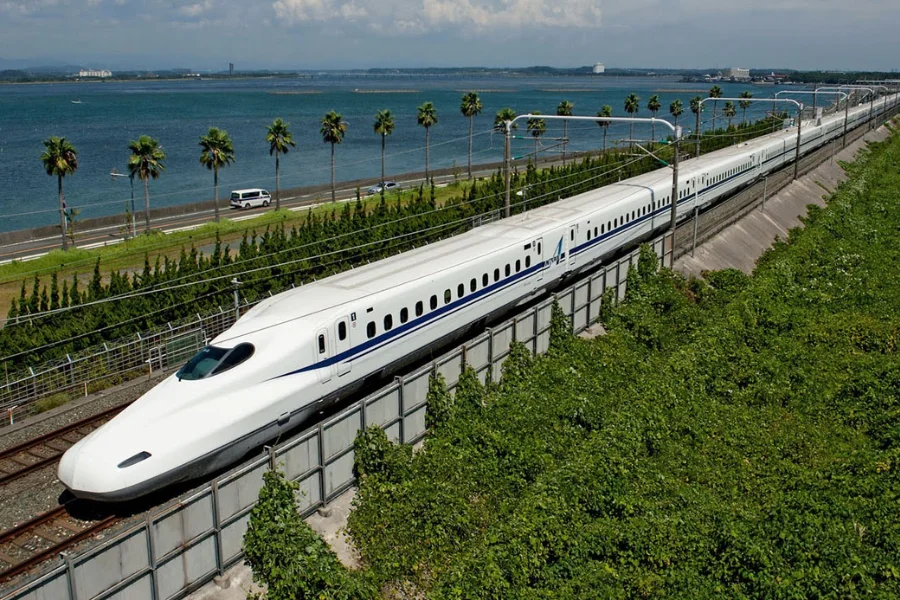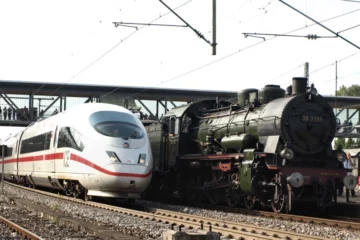From Steam Engines to High-Speed Trains: The Future of Train Travel

High-Speed Trains | bebevy
Train travel has come a long way since the invention of the steam engine. From slow and cumbersome locomotives to sleek, high-speed trains, the future of train travel is looking brighter than ever. With advancements in technology, trains have become faster, more efficient, and more luxurious than ever before. But what does the future of train travel hold? Will we see even faster trains that can rival air travel in speed and convenience? Will we see trains that are powered by renewable energy sources? Or will the focus shift towards creating more sustainable and eco-friendly trains that reduce carbon emissions and preserve the environment? In this article, we’ll explore the exciting possibilities that lie ahead for train travel and how these advancements will change the way we travel forever.
The history of train travel
The history of train travel dates back to the early 19th century when the first steam locomotive was invented. The steam engine revolutionized transportation and paved the way for the development of railways all over the world. In the early days, trains were slow, noisy, and uncomfortable. Passengers had to endure long journeys on hard, wooden seats, and trains were often delayed due to technical problems.
However, over time, train travel evolved and became more comfortable and efficient. The introduction of diesel and electric engines in the mid-20th century made trains faster and more reliable. Passenger cars became more luxurious with amenities such as air conditioning, reclining seats, and onboard dining.
Today, train travel continues to be an important mode of transportation for people all over the world, with high-speed trains whisking passengers between cities in record time.
Advancements in train technology
Advancements in train technology have played a significant role in improving train travel over the years. From the development of diesel and electric engines to the creation of high-speed trains, technology has made trains faster, more efficient, and more comfortable for passengers.
One of the most significant advancements in train technology is the development of magnetic levitation, or maglev, trains. Maglev trains use magnetic levitation to lift the train off the tracks and propel it forward, eliminating the need for wheels. This technology allows trains to travel at extremely high speeds and reduces the amount of friction and wear on the tracks.
Another important development in train technology is the use of computer systems to control trains. These systems allow trains to operate more efficiently, reducing energy consumption and improving safety. In addition, many modern trains are equipped with sensors and monitoring systems that help detect and prevent technical problems.
High-speed trains around the world
High-speed trains have become increasingly popular in recent years, with many countries investing in high-speed rail networks to connect major cities and improve transportation. Some of the fastest high-speed trains in the world include the Shanghai Maglev train in China, which can reach speeds of up to 430 km/h, and the TGV in France, which can travel at speeds of up to 320 km/h.
In Japan, the Shinkansen bullet train is a famous example of high-speed train travel. The Shinkansen has been in operation since 1964 and has a perfect safety record, making it one of the safest forms of transportation in the world. The trains can travel at speeds of up to 320 km/h and offer passengers a comfortable and efficient way to travel between cities.
In the United States, high-speed rail has been slower to catch on, but there are plans to develop high-speed rail networks in California, Texas, and Florida. These networks could potentially connect major cities and reduce travel times significantly.
The benefits of train travel
There are many benefits to train travel, including speed, comfort, and convenience. Trains can travel at high speeds, reducing travel time between cities and making it easier for people to get around. In addition, many modern trains offer amenities such as comfortable seating, air conditioning, and onboard dining, making train travel a more comfortable and enjoyable experience.
Another benefit of train travel is its lower environmental impact compared to other modes of transportation. Trains are more fuel-efficient than cars and airplanes, and many trains today are powered by renewable energy sources such as wind and solar power. This makes train travel a more sustainable and eco-friendly option for those looking to reduce their carbon footprint.
The environmental impact of train travel
While train travel is generally considered to be more environmentally friendly than other modes of transportation, it still has an impact on the environment. Trains emit greenhouse gases such as carbon dioxide, which contribute to climate change. In addition, trains can have a negative impact on wildlife and ecosystems, particularly when railway tracks are built through sensitive habitats.
To reduce the environmental impact of train travel, many countries have implemented measures such as electrifying tracks, using renewable energy sources, and improving energy efficiency. In addition, some trains have been designed to reduce noise pollution and minimize their impact on wildlife.
The future of train travel technology
The future of train travel technology is exciting and holds many possibilities. One of the most promising developments is the use of hyperloop technology. Hyperloop technology involves the use of magnetic levitation to propel a pod through a vacuum-sealed tube at high speeds. This technology has the potential to revolutionize transportation by allowing passengers to travel at speeds of up to 1,000 km/h, reducing travel times between cities to just minutes.
Other potential developments in train travel technology include the use of artificial intelligence to improve safety and efficiency, the development of self-driving trains, and the use of renewable energy sources to power trains.
Hyperloop technology and its potential impact on train travel
Hyperloop technology has the potential to transform train travel by offering a faster, more efficient mode of transportation. Hyperloop pods can travel at speeds of up to 1,000 km/h, reducing travel times between cities to just minutes. This technology could potentially revolutionize transportation and make it easier for people to get around.
However, there are still many challenges that need to be overcome before hyperloop technology can become a reality. One of the biggest challenges is developing a cost-effective and safe system that can be implemented on a large scale. In addition, there are concerns about the potential environmental impact of hyperloop systems, particularly if they are not powered by renewable energy sources.
Challenges facing the future of train travel
Despite the many advancements in train travel technology, there are still challenges that need to be overcome. One of the biggest challenges is the high cost of developing and implementing high-speed rail networks. Many countries have been slow to invest in high-speed rail due to the high cost of building and maintaining rail infrastructure.
In addition, there are concerns about the safety and security of high-speed trains, particularly when traveling at speeds of over 300 km/h. There are also concerns about the potential impact of high-speed rail on wildlife and ecosystems, particularly when tracks are built through sensitive habitats.
The role of government in supporting train travel
Governments play a crucial role in supporting train travel by investing in rail infrastructure and promoting the development of high-speed rail networks. Many countries have implemented policies to encourage the use of trains, such as offering subsidies for rail travel and implementing carbon taxes to discourage the use of cars and airplanes.
In addition, governments can support the development of sustainable and eco-friendly train travel by investing in renewable energy sources and implementing measures to reduce the environmental impact of train travel.
Conclusion – why train travel is still relevant and important today
Train travel has come a long way since the invention of the steam engine, and the future of train travel looks brighter than ever. With advancements in technology, trains have become faster, more efficient, and more luxurious than ever before. From high-speed trains to hyperloop technology, the possibilities for train travel are endless.
Despite the challenges facing the future of train travel, it remains an important mode of transportation that offers many benefits, including speed, comfort, and sustainability. By investing in train travel and supporting the development of high-speed rail networks, governments can help to create a more sustainable and efficient transportation system that benefits everyone.








